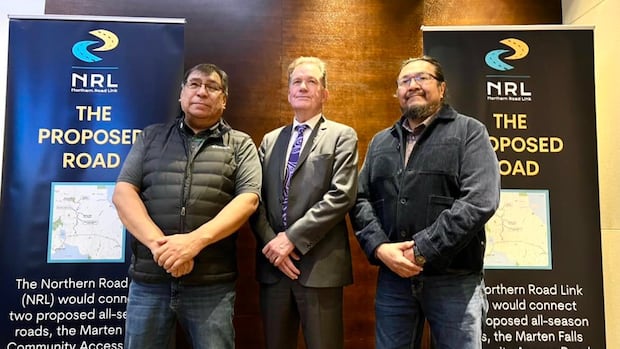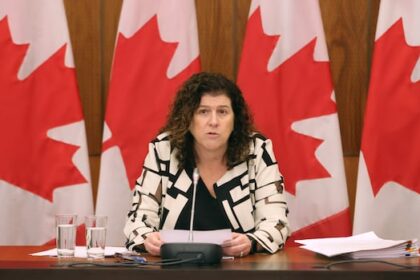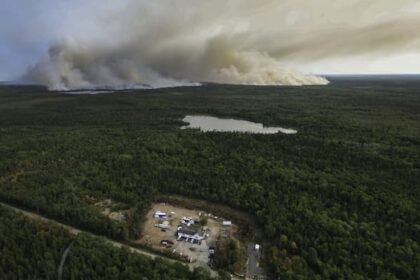Thunder BayWebequie First Nation has completed the public review for the proposed 107-kilometre Webequie Supply Road. Once built, the two-lane, all-season road would connect the fly-in community to future mineral exploration zones in the Ring of Fire region. All-season road would connect First Nation to development area near McFauld’s LakeRajpreet Sahota · CBC News · Posted: Oct 24, 2025 4:06 PM EDT | Last Updated: 3 hours agoListen to this articleEstimated 6 minutes(Left to right) Webequie Chief Cornelius Wabasse, Ontario mines minister George Pirie, and Marten Falls Chief Bruce Achneepineskum, are seen during a press conference at the Prospectors and Developers Association of Canada conference in Toronto. (Submitted by Stephanie Ash)Webequie First Nation, a remote community about 540 km north of Thunder Bay, Ont., is taking a major step forward in its effort to build a supply road.It marks what Chief Cornelius Wabasse calls “a major achievement” in one of Canada’s “most significant Indigenous-led infrastructure projects.”The community has wrapped up the 60-day public review period for its draft Environmental Assessment Report and Impact Statement for the proposed Webequie Supply Road. The Environmental Assessment report is required under Ontario’s Environmental Assessment Act, and the Impact Assessment falls under Canada’s Impact Assessment Act. The review ran from Aug. 8 to Oct. 5 this year and followed an earlier 60-day review period exclusively for Indigenous communities. According to Webequie First Nation, the two phases represent one of the most extensive and inclusive environmental review processes ever carried out in northern Ontario.Currently, the community is only accessible by air or winter road. The proposed 107-kilometre, all-season road would connect Webequie First Nation to future development areas near McFaulds Lake in the mineral-rich Ring of Fire region. “Webequie has led this process from the beginning, and we are grateful to the Indigenous communities, governments, organizations and members of the public who took the time to review the draft report and share their perspectives and feedback,” said Wabasse.The project includes 31 water crossings, six bridges and 25 culverts. It is expected to create local jobs, business opportunities and training for community members.Chief Cornelius Wabasse of Webequie First Nation describes the community’s supply road project as one of Canada’s “most significant Indigenous-led infrastructure projects.” (CBC)“The Webequie Supply Road represents more than a road; it is an opportunity for new jobs, business opportunities and training for our youth,” said Wabasse. “It will strengthen Webequie’s economic future while allowing our community to remain deeply connected to our land and traditions.”The several hundred million-dollar project is still in its design phase. That has been guided by Webequie’s Three-Tier Consultation Model, a framework built on “meaningful participation and cultural respect,” according to Webequie First Nation’s press release. It combines Indigenous knowledge and western science to ensure environmental and cultural protection.That includes discussions with land users, elders and youth from both Webequie and Nibinamik First Nation to help define the route of the road.“This milestone accomplishment is indicative of Webequie’s leadership and a testament to our nation-to-nation partnership,” said Greg Rickford, minister of Indigenous affairs and First Nations economic reconciliation, and minister responsible for Ring of Fire economic and community partnerships, in a media release.“We are proud to partner on legacy infrastructure that is grounded in First Nations knowledge and care for the land, and that drives shared prosperity for generations to come.”Greg Rickford is Ontario’s minister of Indigenous affairs and First Nations economic reconciliation, and minister responsible for Ring of Fire economic and community partnerships. (CBC)Marten Falls First Nation is also going through the lengthy process to build a proposed supply road to the Ring of Fire region. In a community update, the First Nation said it has begun the decommissioning of selected groundwater monitoring wells, which involves removing wells that were previously used to monitor groundwater along the proposed road route.As the project has progressed and the route has been refined, the First Nation says the existing wells are no longer ideally located to track potential local effects from the road. This means it’s necessary to remove them in order to maintain accurate environmental monitoring. 2 First Nations working on roads to Ring of Fire speak out against Ontario’s new mining lawMarten Falls is also working on a finalized Community-specific Impact Assessment Report, which has been reviewed by 23 Indigenous communities following a 90-day consultation period.Meanwhile, some First Nations, such as Neskantaga, have expressed long-standing opposition to the road projects.Concerns, opportunities raised during public reviewMichael Fox, the regional consultation lead for the supply road project representing Webequie First Nation, said community feedback throughout the review process covered a range of environmental and logistical concerns.“There were concerns about water, what type of road this is going to be, how it’s going to affect the groundwater or surface water,” Fox said. “There were concerns around wildlife, the type of bridges that will be developed and the type of roads that will be used in terms of the peatlands that are in the area.”New research explores impact of Ring of Fire mining on First Nations in northern Ontario The Draft Environmental Assessment Report also raised concerns about air quality along the corridor, noting that people living in the area could have potential exposure to particulate matter and other contaminants during construction. Webequie officials say these risks would be monitored through comprehensive follow-up programs, including environmental management plans and adaptive monitoring with input from Indigenous communities. The report says many effects are considered reversible or manageable. It also highlights the need for ongoing oversight to protect both human and ecological health.The map, provided by the Northern Road Link project team, shows the three proposed all-season roads connecting remote First Nations to the provincial highway network. The Marten Falls Community Access Road is purple, the Northern Road Link is striped, and the Webequie Supply Road is in red. (Supplied by Stephanie Ash)Fox said people have been asking about future contract opportunities for Indigenous businesses as well as job training programs for Indigenous workers in northwestern Ontario. They also wanted to know if a list of employment opportunities would be created for potential road construction work, if the project is approved. Fox estimates that the community received about 1,000 comments. All comments from the Indigenous and public review phases are now being organized and addressed by the project team. “We’re stacking them, we’re counting them, then we’re sorting them, and then the disciplines will draft responses,” Fox said. “We’re guessing maybe early next year, maybe first quarter of next year, we’ll have all the comments addressed, and then we’ll finalize the final report shortly thereafter.”Once finalized, the report will be submitted to the Ontario Ministry of the Environment, Conservation and Parks and the Impact Assessment Agency of Canada for review and decision.Fox said while it’s too early to set a firm construction start date, discussions have already begun about potential pre-construction work in 2026, if approvals move forward.“We’re just trying to take it one step at a time,” he said. “We’ve done the draft report and public release and review, and now we’re kind of forecasting what needs to be done for next year.”ABOUT THE AUTHORRajpreet Sahota is a bilingual journalist who reports for CBC News stations across Ontario. Tips and story ideas can be sent to rajpreet.sahota@cbc.ca
Wednesday, 17 Dec 2025
Canada – The Illusion
Search
Have an existing account?
Sign In
© 2022 Foxiz News Network. Ruby Design Company. All Rights Reserved.
You May also Like
- More News:
- history
- Standing Bear Network
- John Gonzalez
- ᐊᔭᐦᑊ ayahp — It happened
- Creation
- Beneath the Water
- Olympic gold medal
- Jim Thorpe
- type O blood
- the bringer of life
- Raven
- Wás’agi
- NoiseCat
- 'Sugarcane'
- The rivers still sing
- ᑲᓂᐸᐏᐟ ᒪᐢᑿ
- ᐅᑳᐤ okâw — We remember
- ᐊᓂᓈᐯᐃᐧᐣ aninâpêwin — Truth
- This is what it means to be human.
- Nokoma











